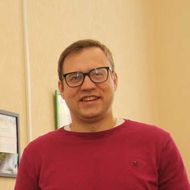Scientists at HSE University Devise More Accurate Method for Predicting the Electrical Conductivity of Electrolyte Solutions

Researchers at HSE MIEM have developed a model for calculating the electrical conductivity of aqueous electrolyte solutions; for the first time, it considers the spatial distribution of ion charges instead of assuming their localisation at a single point. The model remains effective even at high electrolyte concentrations and across a wide temperature range. This breakthrough will contribute to the development of more efficient batteries and enable the calculation of electrical conductivity without the need for experimental testing. The study has been published in the Journal of Chemical Physics.
Electrolytes are substances that dissolve in water to produce charged particles known as ions. When exposed to an electric field, ions in a solution can move and generate an electric current. Thanks to this property, ions play a crucial role in nerve and muscle function, maintaining water balance, storing and releasing energy in batteries, and purifying water in desalination systems.
The electrical conductivity of an electrolyte solution measures its ability to conduct an electric current. Classical theories for calculating electrical conductivity are effective at low concentrations, but as concentration increases, effects arise that these theories do not account for, resulting in discrepancies with experimental data. As a result, obtaining accurate information in systems with limited data on electrical conductivity or where measurements are challenging becomes difficult.
Scientists at HSE University have developed a new model that calculates the electrical conductivity of aqueous electrolyte solutions based on the Debye–Hückel–Onsager theory. Their model accounts for ion specificity, including steric interactions, hydration effects, and spatial charge distributions. Unlike the classical Debye–Hückel–Onsager theory, the modified theory assumes that ion charges are not concentrated at a single point but are instead distributed as clouds, which can be described using a specialised mathematical function.
'We chose not to perform complex calculations of the ion charge distribution function based on first-principles quantum chemistry. Instead, we decided to adjust it by modifying the charge smearing parameter,' explains Yury Budkov, co-author of the paper and Leading Research Fellow at the MIEM HSE Laboratory for Computational Physics.
According to him, incorporating the ion charge distribution function into the theory aligns with modern concepts of matter's structure, based on the quantum theory of multi-electron systems. The new model not only accurately reproduces the experimental relationship between electrical conductivity and concentration at a fixed temperature but also predicts the electrical conductivity of aqueous electrolytes across different temperatures and ion charges. For solutions of sodium, potassium, and lithium chloride salts, the obtained data aligns with experimental results up to concentrations of 4 mol/litre, which represents the best result to date.
In the future, scientists plan to refine the model for non-aqueous electrolyte solutions and adapt it for multicomponent electrolyte systems. This is important from a practical standpoint, as such systems are used in batteries, supercapacitors, and other energy storage devices, where precise calculations of electrical conductivity are essential to improving efficiency and durability.
See also:
Scientists Test Asymmetry Between Matter and Antimatter
An international team, including scientists from HSE University, has collected and analysed data from dozens of experiments on charm mixing—the process in which an unstable charm meson oscillates between its particle and antiparticle states. These oscillations were observed only four times per thousand decays, fully consistent with the predictions of the Standard Model. This indicates that no signs of new physics have yet been detected in these processes, and if unknown particles do exist, they are likely too heavy to be observed with current equipment. The paper has been published in Physical Review D.
HSE Scientists Reveal What Drives Public Trust in Science
Researchers at HSE ISSEK have analysed the level of trust in scientific knowledge in Russian society and the factors shaping attitudes and perceptions. It was found that trust in science depends more on everyday experience, social expectations, and the perceived promises of science than on objective knowledge. The article has been published in Universe of Russia.
Scientists Uncover Why Consumers Are Reluctant to Pay for Sugar-Free Products
Researchers at the HSE Institute for Cognitive Neuroscience have investigated how 'sugar-free' labelling affects consumers’ willingness to pay for such products. It was found that the label has little impact on the products’ appeal due to a trade-off between sweetness and healthiness: on the one hand, the label can deter consumers by implying an inferior taste, while on the other, it signals potential health benefits. The study findings have been published in Frontiers in Nutrition.
HSE Psycholinguists Launch Digital Tool to Spot Dyslexia in Children
Specialists from HSE University's Centre for Language and Brain have introduced LexiMetr, a new digital tool for diagnosing dyslexia in primary school students. This is the first standardised application in Russia that enables fast and reliable assessment of children’s reading skills to identify dyslexia or the risk of developing it. The application is available on the RuStore platform and runs on Android tablets.
Physicists Propose New Mechanism to Enhance Superconductivity with 'Quantum Glue'
A team of researchers, including scientists from HSE MIEM, has demonstrated that defects in a material can enhance, rather than hinder, superconductivity. This occurs through interaction between defective and cleaner regions, which creates a 'quantum glue'—a uniform component that binds distinct superconducting regions into a single network. Calculations confirm that this mechanism could aid in developing superconductors that operate at higher temperatures. The study has been published in Communications Physics.
Neural Network Trained to Predict Crises in Russian Stock Market
Economists from HSE University have developed a neural network model that can predict the onset of a short-term stock market crisis with over 83% accuracy, one day in advance. The model performs well even on complex, imbalanced data and incorporates not only economic indicators but also investor sentiment. The paper by Tamara Teplova, Maksim Fayzulin, and Aleksei Kurkin from the Centre for Financial Research and Data Analytics at the HSE Faculty of Economic Sciences has been published in Socio-Economic Planning Sciences.
'Even among Geniuses, Luck Plays a Role in Winning a Nobel Prize'
Denis Bodrov studies particle physics and works at one of the four electron–positron colliders in the world. In this interview with the HSE Young Scientists project, he talks about his efforts to go beyond the Standard Model, discusses tau leptons, and shares his affection for Moscow.
Larger Groups of Students Use AI More Effectively in Learning
Researchers at the Institute of Education and the Faculty of Economic Sciences at HSE University have studied what factors determine the success of student group projects when they are completed with the help of artificial intelligence (AI). Their findings suggest that, in addition to the knowledge level of the team members, the size of the group also plays a significant role—the larger it is, the more efficient the process becomes. The study was published in Innovations in Education and Teaching International.
New Models for Studying Diseases: From Petri Dishes to Organs-on-a-Chip
Biologists from HSE University, in collaboration with researchers from the Kulakov National Medical Research Centre for Obstetrics, Gynecology, and Perinatology, have used advanced microfluidic technologies to study preeclampsia—one of the most dangerous pregnancy complications, posing serious risks to the life and health of both mother and child. In a paper published in BioChip Journal, the researchers review modern cellular models—including advanced placenta-on-a-chip technologies—that offer deeper insights into the mechanisms of the disorder and support the development of effective treatments.
Using Two Cryptocurrencies Enhances Volatility Forecasting
Researchers from the HSE Faculty of Economic Sciences have found that Bitcoin price volatility can be effectively predicted using Ethereum, the second-most popular cryptocurrency. Incorporating Ethereum into a predictive model reduces the forecast error to 23%, outperforming neural networks and other complex algorithms. The article has been published in Applied Econometrics.



